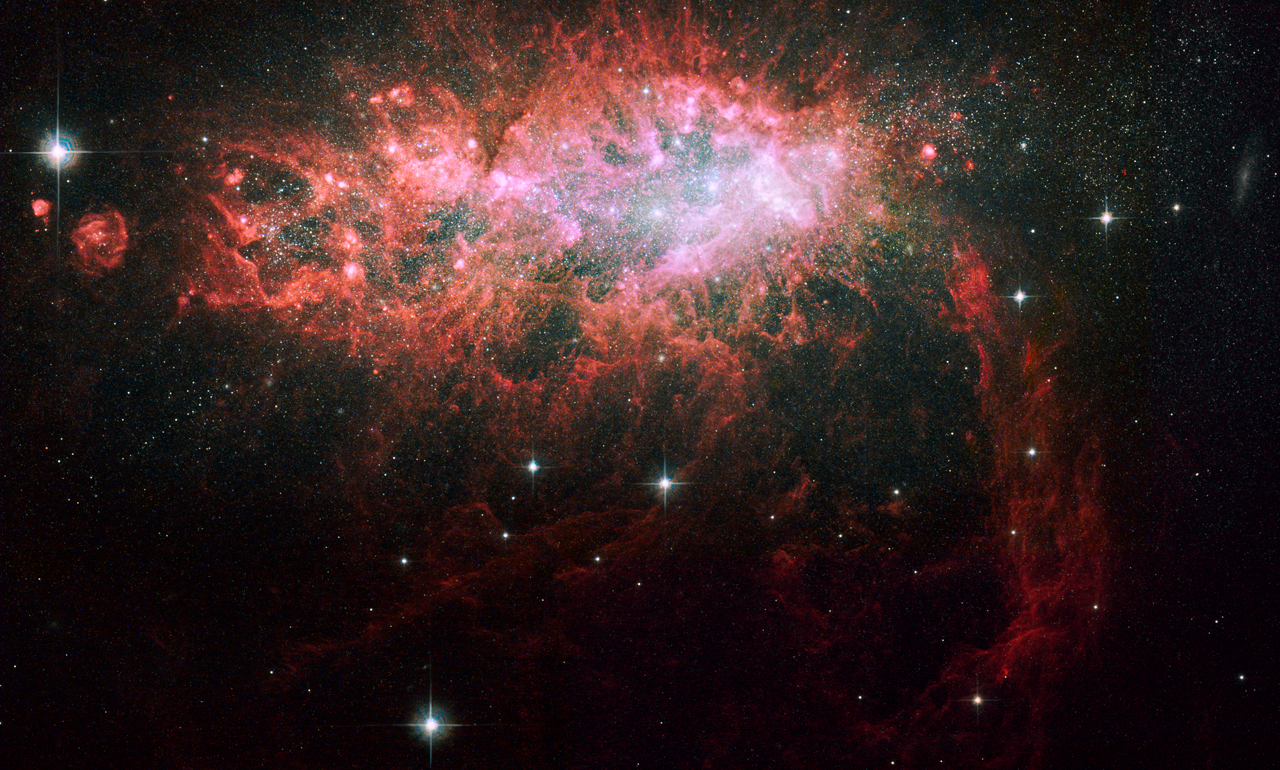Starburst (astronomy) on:
[Wikipedia]
[Google]
[Amazon]
 A starburst region is a region of space that is undergoing a large amount of
A starburst region is a region of space that is undergoing a large amount of
 A starburst region is a region of space that is undergoing a large amount of
A starburst region is a region of space that is undergoing a large amount of star formation
Star formation is the process by which dense regions within molecular clouds in interstellar space—sometimes referred to as "stellar nurseries" or "star-forming regions"—Jeans instability, collapse and form stars. As a branch of astronomy, sta ...
. A starburst is an astrophysical process that involves star formation occurring at a rate that is large compared to the rate that is typically observed. This starburst activity will consume the available interstellar gas supply over a timespan that is much shorter than the lifetime of the galaxy. For example, the nebula NGC 6334 has a star formation rate estimated to be 3600 solar mass
The solar mass () is a frequently used unit of mass in astronomy, equal to approximately . It is approximately equal to the mass of the Sun. It is often used to indicate the masses of other stars, as well as stellar clusters, nebulae, galaxie ...
es per million years compared to the star formation rate of the entire Milky Way
The Milky Way or Milky Way Galaxy is the galaxy that includes the Solar System, with the name describing the #Appearance, galaxy's appearance from Earth: a hazy band of light seen in the night sky formed from stars in other arms of the galax ...
of about seven million solar mass
The solar mass () is a frequently used unit of mass in astronomy, equal to approximately . It is approximately equal to the mass of the Sun. It is often used to indicate the masses of other stars, as well as stellar clusters, nebulae, galaxie ...
es per million years. Due to the high amount of star formation a starburst is usually accompanied by much higher gas pressure and a larger ratio of hydrogen cyanide
Hydrogen cyanide (formerly known as prussic acid) is a chemical compound with the chemical formula, formula HCN and structural formula . It is a highly toxic and flammable liquid that boiling, boils slightly above room temperature, at . HCN is ...
to carbon monoxide
Carbon monoxide (chemical formula CO) is a poisonous, flammable gas that is colorless, odorless, tasteless, and slightly less dense than air. Carbon monoxide consists of one carbon atom and one oxygen atom connected by a triple bond. It is the si ...
emission-lines than are usually observed.
Starbursts can occur in entire galaxies or just regions of space. For example, the Tarantula Nebula
The Tarantula Nebula (also known as 30 Doradus) is a large H II region in the Large Magellanic Cloud (LMC), forming its south-east corner (from Earth, Earth's perspective).
Discovery
The Tarantula Nebula was observed by Nicolas-Louis de Lacaill ...
is a nebula
A nebula (; or nebulas) is a distinct luminescent part of interstellar medium, which can consist of ionized, neutral, or molecular hydrogen and also cosmic dust. Nebulae are often star-forming regions, such as in the Pillars of Creation in ...
in the Large Magellanic Cloud
The Large Magellanic Cloud (LMC) is a dwarf galaxy and satellite galaxy of the Milky Way. At a distance of around , the LMC is the second- or third-closest galaxy to the Milky Way, after the Sagittarius Dwarf Spheroidal Galaxy, Sagittarius Dwarf ...
which has one of the highest star formation rates in the Local Group. By contrast, a starburst galaxy is an entire galaxy that is experiencing a very high star formation rate. One notable example is Messier 82
Messier 82 (also known as NGC 3034, Cigar Galaxy or M82) is a starburst galaxy approximately 12 million light-years away in the constellation Ursa Major. It is the second-largest member of the M81 Group, with the D25 isophotal diameter of . ...
in which the gas pressure is 100 times greater than in the local neighborhood, and it is forming stars at about the same rate as the entire Milky Way
The Milky Way or Milky Way Galaxy is the galaxy that includes the Solar System, with the name describing the #Appearance, galaxy's appearance from Earth: a hazy band of light seen in the night sky formed from stars in other arms of the galax ...
in a region only about across. At this rate M82 will consume its 200 million solar mass
The solar mass () is a frequently used unit of mass in astronomy, equal to approximately . It is approximately equal to the mass of the Sun. It is often used to indicate the masses of other stars, as well as stellar clusters, nebulae, galaxie ...
es of atomic and molecular hydrogen in 100 million years (its free-fall time).
Starburst regions can occur in different shapes, for example in Messier 94 the inner ring is a starburst region. Messier 82
Messier 82 (also known as NGC 3034, Cigar Galaxy or M82) is a starburst galaxy approximately 12 million light-years away in the constellation Ursa Major. It is the second-largest member of the M81 Group, with the D25 isophotal diameter of . ...
has a starburst core of about 600 parsec in diameter. Starbursts are common during galaxy merger
Galaxy mergers can occur when two (or more) Galaxy, galaxies collide. They are the most violent type of Interacting galaxy, galaxy interaction. The Gravitation, gravitational interactions between galaxies and the friction between the gas and Cosmi ...
s such as the Antennae Galaxies. In the case of mergers, the starburst can either be local or galaxy-wide depending on the galaxies and how they are merging.
See also
* ** * * *References